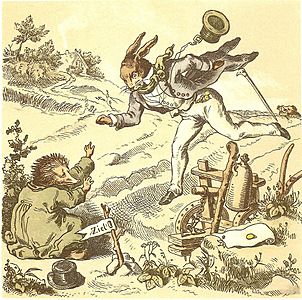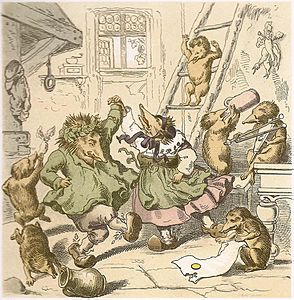The Hare and the Hedgehog facts for kids
Quick facts for kids The Hare and the Hedgehog |
|
|---|---|

Cover of a low-saxon edition published 1855 with illustrations by Gustav Süs.
|
|
| Folk tale | |
| Name | The Hare and the Hedgehog |
| Data | |
| Region | Germany |
| Published in | Kinder- und Hausmärchen, by the Brothers Grimm |
The Hare and the Hedgehog is a well-known fable from Germany. It is also called The race between the Hare and the Hedgehog. This story was first published in 1840 in a newspaper. Later, the famous Brothers Grimm included it in their collection of Grimms' Fairy Tales in 1843.
Contents
The Story of the Race
One sunny morning, a hare was making fun of a hedgehog's short, crooked legs. The hedgehog, feeling annoyed, challenged the hare to a race! The prize would be a gold coin and a bottle of brandy.
When the race began in a field, the hedgehog only ran a few steps. But he had a clever plan! He had secretly placed his wife at the other end of the field. She looked exactly like him.
The hare, sure he would win, ran very fast to the finish line. But when he got there, the hedgehog's wife stood up and shouted, "I'm already here!" The hare was shocked and couldn't believe he had lost.
He demanded another race, and then another! The hare raced 73 times, but each time, the hedgehog (or his wife) was already at the finish line. In the 74th race, the hare was so tired that he collapsed and sadly died.
What the Story Teaches Us
The story starts in a fun way, almost like the narrator is playing a trick. It says the story might sound like a lie, but it must be true because you couldn't tell it otherwise! The hedgehog is shown singing happily in the morning before the hare upsets him.
This fable teaches us a few important lessons:
- Don't make fun of others: The hare made fun of the hedgehog's legs, which was unkind. The hedgehog got his revenge because of this.
- Be clever, not just fast: The hedgehog used his brain to win, even though he was slow.
- Choose wisely: The story also suggests that when you choose a partner, it's good to pick someone who is similar to you, like the hedgehog and his wife.
Where the Story Comes From
The story is set on the Buxtehude Heath in Germany. This location was chosen by Wilhelm Schröder, who first wrote down the tale. He had actually heard the story in a different town, but he decided to move the setting to Buxtehude.
The word "Swinegel" in the story is a common word for "hedgehog" in the local German dialect. It's not meant to be an insult.
The way the story begins, saying it's "a lie to tell, boy, but it is true," is quite unusual for a fairy tale. It makes the reader curious and shows that even a fun story can have a deeper meaning.
Deeper Meaning of the Characters
In the story, the hedgehog represents the "common person" or a farmer. He lives simply and knows his own land. The hare, on the other hand, is like a fancy, proud gentleman. He looks down on others.
So, the race is not just about speed. It's also about different types of people. The lessons from the story fit this idea:
- People who seem less important should not be made fun of.
- It's good to marry someone from a similar background or with a similar way of thinking.
The Brothers Grimm got their version of the story from a newspaper called Hannoversches Volksblatt in 1840. They only changed a few words to make the dialect clearer and gave it a shorter German title.
Stories about slow animals outsmarting fast ones are very old. One famous example is Aesop's fable, The Tortoise and the Hare. In that story, a slow tortoise beats a fast hare in a race by being steady and determined. Similar tales can be found in different cultures around the world.
Other Versions and Adaptations
The story of "The Hare and the Hedgehog" has inspired many other works:
- The writer Günter Grass wrote a short story with the same name.
- A children's song by Fredrik Vahle, released in 1973, tells a musical version of the tale.
- Hare and Tortoise is a board game invented in 1973. It was the first game to win the German "Game of the Year" award in 1979. Its name refers to Aesop's fable.
- There have been movies based on the story, including a German fairy tale movie from 1982.
- The Japanese animated series Gurimu Meisaku Gekijō also featured the story in one of its episodes.
Images for kids






